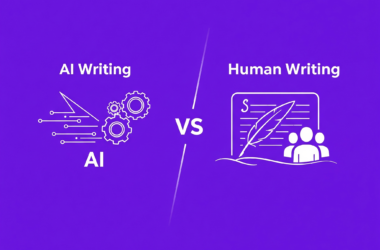Last updated on June 7th, 2024
Table of Contents
- What is Marketing Content Writing?
- 8 Powerful Content Marketing Writing Tips
- 1. Know Your Audience: Speak Their Language
- 2. Craft Headlines That Captivate
- 3. SEO: Get Found in the Content Jungle
- 4. Engage Your Audience: Make Them Want More
- 5. Visual Appeal: The Power of a Picture
- 6. Storytelling: Weave a Captivating Narrative
- 7. Adding the Right CTAs at the right places
- 8. Consider Readability
- Conclusion
Have you ever felt that your blog posts were being lost in the vast sea that is ‘content‘?
You put your heart and soul into creating fascinating content. However, they appear to disappear into thin air, making you wonder whether anyone is consuming your content.
Online content is a prominent choice for marketers in 2024. In fact, over 90% of marketers use it to promote their content.
As such, the internet is overflowing with content, making it difficult to capture attention. And viewers, much like the humble goldfish, lose interest after a few seconds.
Additionally, marketing content can feel a bit forced at times. However, there are plenty of content marketing strategies for beginners available so as to facilitate the creation of more natural and engaging content for audiences.
What is Marketing Content Writing?
Marketing content writing entails developing engaging information for readers. As such, there is quite a focus on educating and turning readers into consumers. Marketing content writing is an essential part of digital marketing, which includes blog articles, social media updates, email newsletters, and more.
These articles do more than just market your product or service; they usher in and position your company as a leader. It’s no secret that generating quality content attracts new consumers. What’s more amazing is that this activity also fosters trust among your audience and, eventually, generates conversions.
8 Powerful Content Marketing Writing Tips
Now that we’ve explained what marketing content writing means, let’s look at a curated list of 8 effective content writing techniques to help you succeed with marketing content writing.
1. Know Your Audience: Speak Their Language
Before we start, visualize attempting to sell something to someone in a packed room. Not very practical, right? The same goes for content generation.
The first step is getting to know your target audience. Understanding your target audience is essential for generating effective marketing material. Try to answer these questions.
- Who are you trying to reach?
- Are they busy professionals looking for answers to complex problems or young adults looking for fast, amusing content?
It is essential to address these questions and find an optimal solution. Let’s look at an example to understand how to get to know your ideal customer:
For this example, envision creating a project management tool like Notion. Wouldn’t it be great to know exactly who uses it?
Sure, you can add features, but if you don’t know if children are using it for school assignments or young professionals are juggling job activities, how can you tailor it to their needs?
This is where demographics come in. Knowing your users’ ages, locations, and even jobs allows you to communicate in their language. Understanding demographics allows you to target the appropriate features and messages.
But wait, there’s more! Assume a group of creative people utilize your email marketing platform (such as Mailchimp). Wouldn’t it be nice to provide them exactly what they require? Special email designs for designers, or interfaces with their preferred software? Understanding your audience’s interests allows you to create features and content that will resonate with them.
And lastly, there are pain points. These are the struggles that keep users up at night. For your project management app, maybe it’s information overload. Develop features to categorize information or integrate to-do lists. Pain points help you solve user problems and make them love your product even more.
Building buyer personas provides significant insights into your target audience’s wants and preferences. This helps you to adapt your approach and language so as to better appeal to them.
Here are some examples that can help you adapt your content to different audiences.
|
Audience |
Tone |
|
Gen Z (18-24 years old) |
Casual, conversational, emojis, internet terms |
|
Millennials (25-40 years old) |
Informative, engaging, relatable |
|
Gen X (41-56 years old) |
Direct, authoritative, solution-oriented |
|
Baby Boomers (57-75 years old) |
Nostalgic, sentimental, trustworthy |
|
Business Professionals |
Formal, professional, persuasive |
|
Fitness Enthusiasts |
Motivational, encouraging, informative |
|
Travel Blog Readers |
Storytelling, informative, visually appealing |
|
DIY Hobbyists |
Informative, instructional, step-by-step |
Note: These are examples, and there will be variations within each audience segment.
2. Craft Headlines That Captivate
Ever noticed how some headlines grab your attention while others are so forgettable that you just scroll past without so much as a second glance?
A captivating headline is the gateway to your content. It’s your first impression, and it needs to be powerful enough to entice readers to click and delve deeper.
Here are some secrets to crafting headlines that convert:
Grab attention and make it easy to understand what your content is about. For example, look at this title, “Iconic Creative B2B Marketing Campaigns from the Past Years.“

The title grabs attention in two ways. First, it uses the word “Iconic,” which sparks curiosity about what campaigns might be considered legendary. Second, it mentions “B2B Marketing Campaigns,” which tells the reader exactly what to expect.

Also, numbers pique curiosity, and powerful words create a sense of urgency or excitement. For example, “23 Top Content Writing Tools for SEO To Scale Up Your Growth.”
The title uses the number “23” to pique curiosity. It suggests a specific, actionable list is waiting to be discovered rather than a vague discussion on content writing tools.
3. SEO: Get Found in the Content Jungle
The next issue that most content marketers face is optimizing content for SEO.
Imagine this: You are creating incredible material, but no one sees it. Sad, isn’t it? That is where Search Engine Optimization (SEO) comes in. SEO helps your content rank higher in search engine results pages (SERPs), making it more visible to your intended audience.
Here are some fundamental SEO tips for content writers:
- Determine what keywords your target audience searches for. Tools such as Google Keyword Planner can assist you with this.
- Optimize your title and meta description to include your target keywords naturally while prioritizing readability.
- Use keywords throughout your article. Don’t stuff them excessively. Focus on crafting applicable and quality content that incorporates keywords.
SEO is a continuous effort, but following these simple measures can help you get you market your content such that it’s easily discoverable.
Still struggling to climb the search engine ranks? At Wittypen, our experienced writers craft engaging content optimized for SEO, making it easier for potential customers to find you online. Just tell us your content needs, and we’ll handle the rest!
4. Engage Your Audience: Make Them Want More
The key to successful marketing is keeping your audience engaged. Here are some creative content ideas to engage your audience and make them want more.
- Refrain from relying on lengthy blocks of text. Mix storytelling, facts, quotations, statistics, infographics, and other content styles to keep readers engaged.
- Initiate discussion and foster engagement. Pose questions throughout your material to encourage readers to consider and interact.
- Large amounts of text might be frightening. Thus, use subheadings to divide your text into manageable chunks. Use high-quality photographs, infographics, or videos to improve comprehension and visual appeal.
To understand these points, let’s look at an example. Here is a blog post “How to Create a Content Calendar That Gets Results”

- The post doesn’t just list steps for creating a content calendar. It starts with a story about a marketing team struggling with disorganized content creation.
- Throughout the post, the author asks questions like “What are your biggest content marketing challenges?” and “What content formats resonate most with your audience?” to spark reader engagement.
- The blog post incorporates infographics outlining the steps for creating a content calendar and high-quality screenshots showcasing relevant software features.
HubSpot’s blog keeps readers interested by following these practices. It provides valuable solutions to marketing challenges and subtly positions its software as a potential answer.
Remember: Engaged readers are more likely to remember your brand, share your content, and become loyal customers.
5. Visual Appeal: The Power of a Picture
Visuals are a very effective instrument when it comes to creating impactful content for brands. A compelling visual can capture the reader’s attention, motivating them to look into your content more.
Consider this: have you ever clicked past a blog page because the structure of the text seemed too intimidating? We have all been there. A well-placed image may serve as a hook for readers, causing them to desire to learn more.
But graphics aren’t only for aesthetics; they can also be extremely effective at expressing complicated information.
Consider, for example, price arrangements for a SaaS product. A simple and brief graphic may quickly demonstrate to potential clients the various plans and their characteristics, but a lengthy paragraph may confuse them.

Source: Hubspot
Here’s a great example: Hubspot, a major CRM platform, uses infographics extensively on its blog to explain complex marketing concepts in a visually appealing way. One infographic, for instance, marketers who use generative AI. It’s clear, colourful, and packed with valuable information – a perfect example of how visuals can simplify complex topics for readers.
6. Storytelling: Weave a Captivating Narrative
People relate to tales, as they evoke emotions and make things memorable. Storytelling also helps you connect with your audience at a deeper level, so there’s also that.
Here’s how to include storytelling in your marketing content writing:
- Don’t simply tell the readers how fantastic your product or service is; show them! Create tales highlighting your brand’s benefits and how it addresses client concerns
- Create personalities that your audience can relate to. Place these people in scenarios that reflect their pain areas.
- Stories that evoke human emotions, such as hope, laughter, or inspiration, have a lasting impact

Here’s an example of how Fitbit engages with their audience with their customers’ success stories. Instead of merely listing features, they describe how a busy professional used the tracker to attain exercise objectives and enhance their general well-being.
7. Adding the Right CTAs at the right places
A CTA (Call to Action) tells your viewers what to do next. Whether signing up for your email, downloading an eBook, or making a transaction. Essentially, a great CTA is critical for increasing conversions.
Here’s how content creation best practices craft effective CTAs:
- Make what you want the reader to do is clear. Use strong verbs like “download,” “subscribe,” or “learn more.”
- Sometimes, a sense of urgency can encourage action. Use phrases like “limited time offer” or “download now.”
- Place your CTA at the end of your content, but also consider mid-article CTAs to capture interest throughout the piece.
Let’s try to understand these points:
You know, those buttons that indicate what readers should do next? They’re like helpful nudges that point readers in the correct way. Instead of a weak “Click here,” use a strong “Download our Free Social Media Guide Now!” this creates a FOMO as people will not want to miss out on free resources. And, you can get access to their contact details.
8. Consider Readability
Readability is often overlooked but crucial for effective content marketing writing.
Picture yourself working and spending hours crafting a masterpiece. It’s disappointing when readers abandon such a work because they find it difficult to understand.
Here are some engagement strategies for content marketing to enhance the readability of your marketing content writing:
- Avoid jargon and technical terminology that your readers may not grasp.
- Combining short and significant phrases makes your writing exciting and prevents monotony.
- Break down complex material into manageable parts.
- Typos and grammatical faults can undermine your trust.
Conclusion
Crafting compelling marketing content writing takes time and dedication, but the rewards are significant. Following these eight tips, you now know how to improve content writing skills and create engaging content that resonates with your audience. This content can help establish your brand as a thought leader and, ultimately, drive conversions.
Remember, marketing content writing is a marathon, not a sprint. Stay consistent, keep learning, and adapt your strategy based on results.
Stuck creating material that Google ignores? Wittypen can help you create content that your audience will want to read. Let us help you make your content a conversation starter!








